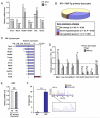The PTTG1-binding factor (PBF/PTTG1IP) regulates p53 activity in thyroid cells
- PMID: 24506068
- PMCID: PMC4759943
- DOI: 10.1210/en.2013-1646
The PTTG1-binding factor (PBF/PTTG1IP) regulates p53 activity in thyroid cells
Abstract
The PTTG1-binding factor (PBF/PTTG1IP) has an emerging repertoire of roles, especially in thyroid biology, and functions as a protooncogene. High PBF expression is independently associated with poor prognosis and lower disease-specific survival in human thyroid cancer. However, the precise role of PBF in thyroid tumorigenesis is unclear. Here, we present extensive evidence demonstrating that PBF is a novel regulator of p53, a tumor suppressor protein with a key role in maintaining genetic stability, which is infrequently mutated in differentiated thyroid cancer. By coimmunoprecipitation and proximity-ligation assays, we show that PBF binds specifically to p53 in thyroid cells and significantly represses transactivation of responsive promoters. Further, we identify that PBF decreases p53 stability by enhancing ubiquitination, which appears dependent on the E3 ligase activity of Mdm2. Impaired p53 function was evident in a transgenic mouse model with thyroid-specific PBF overexpression (transgenic PBF mice), which had significantly increased genetic instability as indicated by fluorescent inter simple sequence repeat-PCR analysis. Consistent with this, approximately 40% of all DNA repair genes examined were repressed in transgenic PBF primary cultures, including genes with critical roles in maintaining genomic integrity such as Mgmt, Rad51, and Xrcc3. Our data also revealed that PBF induction resulted in up-regulation of the E2 enzyme Rad6 in murine thyrocytes and was associated with Rad6 expression in human thyroid tumors. Overall, this work provides novel insights into the role of the protooncogene PBF as a negative regulator of p53 function in thyroid tumorigenesis, in which PBF is generally overexpressed and p53 mutations are rare compared with other tumor types.
Figures






References
-
- Chen AY, Jemal A, Ward EM. Increasing Incidence of Differentiated Thyroid Cancer in the United States, 1988–2005. Cancer. 2009;115:3801–3807. - PubMed
-
- Bhaijee F, Nikiforov YE. Molecular Analysis of Thyroid Tumors. Endocr Pathol. 2011;22:126–133. - PubMed
-
- Mazzaferri EL, Jhiang SM. Long-Term Impact of Initial Surgical and Medical Therapy on Papillary and Follicular Thyroid-Cancer. Am J Med. 1994;97:418–428. - PubMed
-
- Nixon IJ, Ganly I, Patel SG, Palmer FL, Di Lorenzo MM, Grewal RK, Larson SM, Tuttle RM, Shaha A, Shah JP. The Results of Selective Use of Radioactive Iodine on Survival and on Recurrence in the Management of Papillary Thyroid Cancer, Based on Memorial Sloan-Kettering Cancer Center Risk Group Stratification. Thyroid. 2013;23:683–694. - PubMed
-
- Xing MZ, Alzahrani AS, Carson KA, Viola D, Elisei R, Bendlova B, Yip L, Mian C, Vianello F, Tuttle RM, Robenshtok E, Fagin JA, Puxeddu E, Fugazzola L, Czarniecka A, Jarzab B, O’Neill CJ, Sywak MS, Lam AK, Riesco-Eizaguirre G, Santisteban P, Nakayama H, Tufano RP, Pai SI, Zeiger MA, Westra WH, Clark DP, Clifton-Bligh R, Sidransky D, Ladenson PW, Sykorova V. Association Between BRAF V600E Mutation and Mortality in Patients With Papillary Thyroid Cancer. Jama-J Am Med Assoc. 2013;309:1493–1501. - PMC - PubMed
Publication types
MeSH terms
Substances
Grants and funding
LinkOut - more resources
Full Text Sources
Other Literature Sources
Molecular Biology Databases
Research Materials
Miscellaneous

